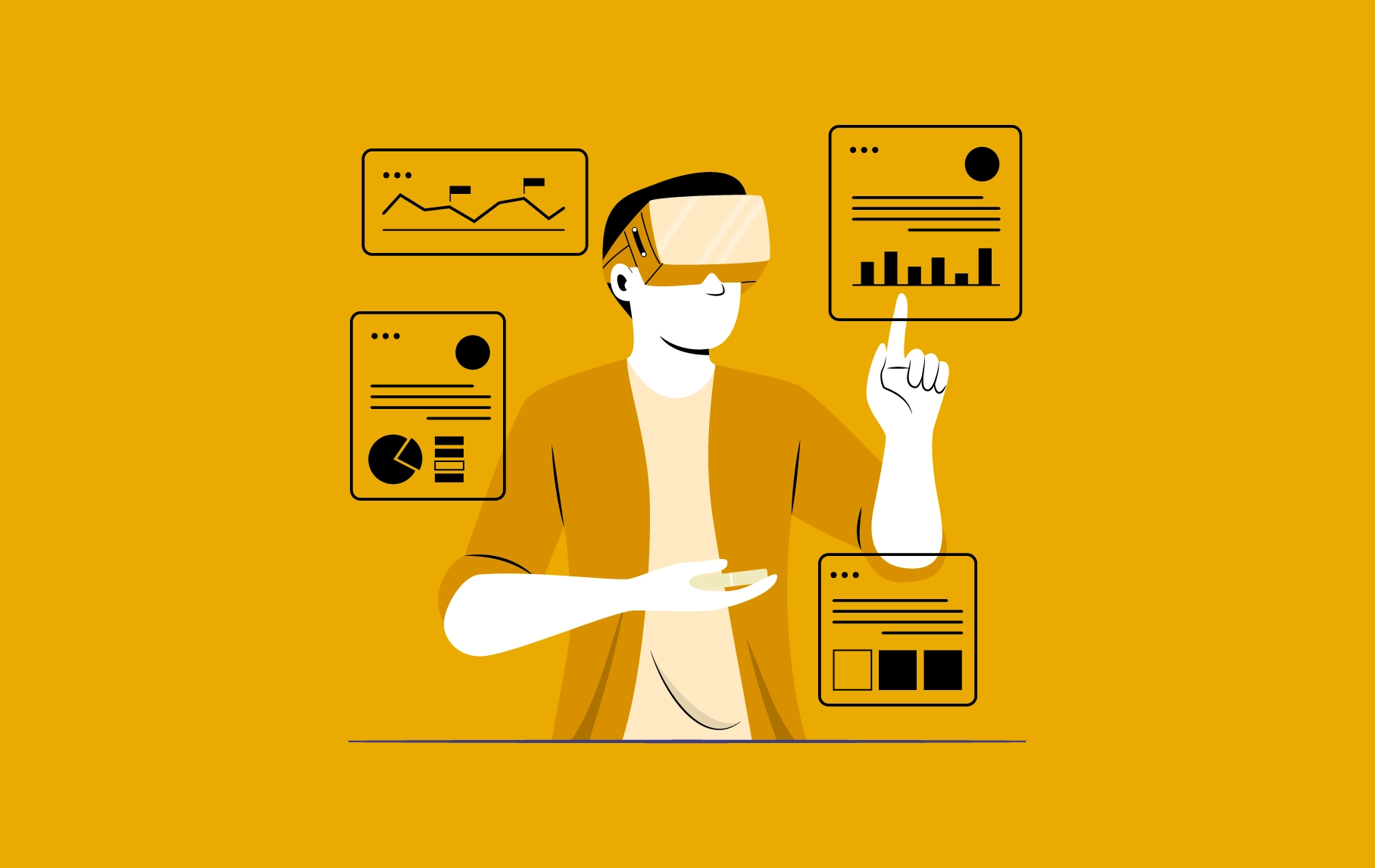- The evolution: What led to metaverse in the banking industry
- Traditional banking
- Internet banking
- Open banking
- Digitalized finance banking
- Metaverse in the banking sector
- The metaverse opportunity for banks
- The benefits of metaverse in banking
- Elevation of existing functionalities in 3D
- Multi-faceted customer engagement
- Invent new products
- How does Appinventiv approaches banking in the metaverse?
- Parting notes
In the olden days, banks were used to deposit and withdraw banknotes. Then ATMs came into the picture with debit and credit cards, and electronic payments soon followed, eliminating the need to visit ATMs or even carry cash.
With the banking industry being one of the primary sectors getting affected by every wave of digitalization, what if the next change around the corner is the introduction of metaverse technology in banking?
Imagine virtually entering a bank branch and taking the help of customer rep avatars to enter the vault and digitally deposit or take out money. Imagine being given the option to pay with dollars in your savings account or a digital currency issued by the bank or even through tokens from a digital wallet like Ethereum. All of these far-fetched theories hold the potential to come true at the back of banking in the metaverse.
In this article, we are going to dive into facets like – the business opportunity for metaverse in banking, the benefits of metaverse banking, the banks which have already entered the space, and how banks should plan out their metaverse entry.
At Appinventiv, when someone asks us what metaverse is in banking, we answer with we look at Metaverse as a new paradigm that is powered by a culmination of multiple next-gen technologies. Technologies that are a combination of decentralized and immersive tech stack. While decentralized technologies like NFT, DLT, and Web3 offer a resilient infrastructure and secure exchange approach, immersive technologies like AR/VR creates an enhanced virtual experience.
In order to truly understand the potential of metaverse use cases in banking, it is necessary to look at the evolution of banks – something that brought them to a stage where the industry is now prepared to introduce a new chapter.
The evolution: What led to metaverse in the banking industry
At the time of writing this article, the banking industry has entered the fourth phase of evolution, with NFTs and cryptos coming to the forefront. At the same time, a handful of banking institutions have entered the fifth – the metaverse stage.
Let us look at the evolution phases of metaverse bank and the issues that built up to it.

Traditional banking
It was a two-tiered banking phase ruled by central banks that relied on one-on-one interactions with customers in a physical space. The stage was known for being paper-based and heavily manual, with an absence of financial product customizations and personalization.
Internet banking
Digitalization of the banking industry came into full force in the last decade. It was divided into two categories – one where the existing processes were digitalized to be accessed through mobile and the internet and the second stage was where new customer journeys were made to address the digital-first demand of customers.
Open banking
In the last three to five years, the banking industry has opened itself to be connected with third-party services via APIs. This has led to a number of neo-banks, cross-industry marketplace offers by banks (for example: health services, buy and sell automotives, energy services, etc.) coming into existence.
Digitalized finance banking
With the advent of Web3, blockchain has given birth to a new secure, borderless, and fast banking economy. A huge role in this is played by NFTs and cryptos, which have added entirely new assets to the financial market, like art, gaming, and real estate.
Metaverse in the banking sector
In the last one-two years, the metaverse has gained massive traction among a range of industries, with banking being one of them. With virtual banking experience taking center stage, the industry is set for another massive revolution.
Now that we have looked into the evolution of banks leading to the metaverse financial services, let us dive into the concept further.
The metaverse opportunity for banks
Morgan Stanley and Goldman Sachs found that the metaverse domain is set to be as big as $8 trillion in the coming time. In this market valuation, banks have a critical role to play. Using technologies like AR/VR and cryptocurrencies, banks will be able to reimagine how they interact with their customers and with what offerings.

Although the technology holds massive potential for the banking industry by answering the many issues customers face, the banks which have entered the domain are still finding their space. Let me explain by giving you examples of the current metaverse use cases in banking.
- JP Morgan – They have opened an Onyx lounge in Decentraland metaverse where they facilitate cross-border payments, financial assets creation, safekeeping, and trading.
- HSBC – They have invested in a plot at The Sandbox metaverse, which will be developed for engaging with the gaming and esports fans.
- Standard Chartered – The bank has also acquired land in The Sandbox, which it plans to use for experimenting and creating new experiences for clients on the metaverse.
- Siam Commercial Bank – They are the first banking group to have built headquarters in The Sandbox. The space comes with three zones: a) A virtual hub: A space for events and knowledge sharing. b) Virtual land: A space for partnered businesses to connect over project development activities. c) Hub: It helps promote local artists via the NFT gallery, NFT marketplace, and virtual concerts.
While these are only some of the top names in the metaverse banking space, there are a number of other banks entering the domain as we discuss this revolution. But what are banks getting from investing in metaverse efforts? After all, they have come to a stage where they are irreplaceable, so why change? Here’s why.
[Also Read: How Much Does it Cost to Develop the Metaverse?]
The benefits of metaverse in banking
Banking in the metaverse comes with a range of benefits for the traditional industry. Benefits that don’t just impact customer experience but also open up new financing models.
Elevation of existing functionalities in 3D
With 47% of bankers rooting for AR/VR as an alternative transactions channel by 2030, a number of banks have started training their employees on VR. For example, Bank of America has developed a VR training program for its 50,000 employees that would simulate real customer scenarios. Moreover, BNP Paribas has even launched a VR app that enables users to perform banking transactions using VR.
Enabling 3D employee and customer experiences will open banks to elevated offerings where they are able to connect with a new target audience and establish their prominence. To summarize, here are the benefits of using 3D for banks.
- Metaverse banking: Offer customers the ability to view their balance, pay the bills, and make transfers through AR/VR platforms.
- Employee experiences: Deliver an immersive learning experience through simulated customer scenarios and onboarding remote workers with a feeling of community.
Multi-faceted customer engagement
Banking in the metaverse gives institutions the opportunity to relook at how they interact with their customers and what they can do to deliver empathetic service through avatars. The experience-focused answer to how metaverse will affect financial services is two-fold:
- Personalized connect: In the metaverse, banks can give high-touch service to the customers by giving them a virtual look into the portfolio and expense revenue, having virtual financial planning sessions, and making well-strategized product recommendations.
- Brand extension: Banks can extend their physical experience in the virtual world by mimicking events like ATMs cash withdrawals, branch placement and layout, and more. This would help customers feel connected with the bank.
Invent new products
Banking in the metaverse comes with numerous opportunities to tap the space with innovative banking products like –
- Digital payments
- Digital assets like NFTs and cryptocurrency
- Digital twin
What this results in is – a) Creating a sense of connectivity between physical and virtual banks and b) Opening new sources of revenue for banks.
So here were the three critical metaverse benefits in banking. But from a bank’s perspective, entering the space can be very challenging. After all, it takes them towards complete virtualization – an area which is massively unexplored. Now while it has been comparatively easier on finance in metaverse, banking institutions require planning and milestone wise goals to approach metaverse technology in banking.
How does Appinventiv approaches banking in the metaverse?
At Appinventiv, one of the leading banking software development company, when we work for financial institutions on metaverse development services, we often suggest our clients to follow a milestone-based approach towards the technology. Here’s what it looks like for banks.
Short-term strategy – We advise banks to focus on the existing metaverses where they can find potential customers, offer lending and payment services, and onboard them through digital wallets.
We also suggest them to target new customer segments like artists, gamers, and creators via services like instant loans, financial planning, and concierge services.
Mid-long term strategy – By the time banks reach this stage, they would already have digital assets, custody platform for supporting the virtual banking world’s needs. So now the banks can even consider building their own digital world and introduce financial products that can be tied back to their traditional offerings
Achieving these strategies would require the banks to hire people with future-driven skills like game designers, 3D artists, metaverse platform experts, and dedicated blockchain developers. The catch here is that investing in them in-house is not just expensive but also managing resources when the platform is set up will become difficult.
This is the reason why banks and financial institutions choose to partner with us. In addition to having all the necessary skill sets, we have working knowledge of connecting the virtual and real banking world through AI, NFTs, AR/VR, and digital twin architectures. We use the technologies to streamline ownership of data, perform risk management, and create an architecture for a security-first foundation of finance in metaverse. Furthermore, we can also assist businesses in embracing sustainable banking practices, ensuring financial operations support environmental and social governance goals.
Parting notes
Banking is on the brink of a never-seen-before digital transformation. Metaverse in fintech is a lot more than a technological shift that would open new sources of revenues. It is a platform which banks can use to reconnect with their customers in a new space and build emotional, personalized engagements with them.
What banks do today, especially with some of the world’s leading banks having already entered the metaverse, will define their openness towards digitalization. Banks that don’t take the leadership position today will end up finding space in others’ ecosystems.
The time to enter the space is now and we can help. Get in touch with our team of blockchain and fintech experts today.


Excellence Together

Building Virtual Worlds: How Digital Twins Power the Enterprise Metaverse
The metaverse is changing the online world. Just like Web 3.0, it's a game changer for businesses. Central to this change is Digital Twins, a leading-edge technology that makes the virtual worlds of the metaverse possible. The metaverse will likely be the next considerable economic power when the internet blends with real life. Estimates show…

Metaverse in Training: Top 7 Use Cases and Benefits
The concept of the metaverse in training is revolutionizing how we approach learning and skill development. Experts predict a growth in the metaverse education market to an impressive $24.7 billion by 2030, showcasing a 43.76% CAGR during the 2023-2030 forecast period. This surge in interest is not surprising, given the unique benefits and applications of…











